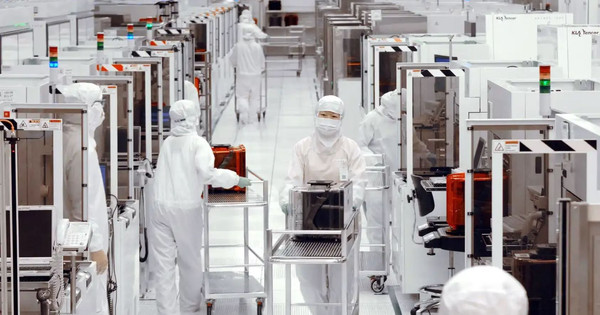The world no longer lacks semiconductor chips
- Tram Ho
Main content:
The global semiconductor chip supply officially ended the shortage. The misrepresentation of demand in the supply chain is part of the reason for the increase in chip inventories. The global semiconductor industry entered a cycle of slowing growth.
Inventories at the world’s top semiconductor suppliers such as Intel, TSMC and Micron skyrocketed, as shown in the third quarter financial statements of 2022. The global semiconductor supply shortage has actually ended after more than 2 years. This is the main raw material for the production of semiconductor chips – an indispensable device in most electronic items such as phones, cars, home appliances, etc.
The need to buy computers to work remotely no longer exists, inflation pressure also makes consumers hesitate to buy smartphones or home appliances.
Even demand for chips for data centers and high-end smartphones, while still strong, tends to wane.

Chip firms’ profits decline
“The sudden and clear slowdown in demand exceeded our initial forecast and is now having an impact on the semiconductor industry across the electronics supply chain,” said Intel CEO Pat Gelsinger. .
In the third quarter, Intel’s net profit fell 85% from a year earlier.
Samsung Electronics also reported a 49% decline in operating profit in the semiconductor business.
Companies specializing in memory chips are even more damaged than companies that make microprocessors like Intel or electronics like Samsung. American company Western Digital reported a 96% drop in net profit.
Even Taiwanese semiconductor company TSMC, which posted an 80% increase in net profit this quarter thanks to a near-monopoly on the supply of high-end 5-nanometer chips, reported demand for a different type of chip (7-nanometer). has decreased slightly. CC Wei, CEO of TSMC, predicts that customers will order less around the first half of 2023.
Supply chain difficulties
In 2020, a spike in consumer demand for electronics, the US-China trade war and supply chain disruptions due to the COVID-19 pandemic made the level of semiconductor supply shortages amplified many times over.
Barriers to entering or expanding semiconductor production include: initial investment costs of billions of USD; It takes about 2 years to build, install and put into operation a chip foundry, while chip products are quickly obsolete.
It is these two pressures that create the Bullwhip effect (also known as the whip effect): information about market demand goes from consumers, through retailers, distributors to manufacturers and suppliers. exaggerated response on the semiconductor supply chain.
Fear of shortages caused car and electronics manufacturers to place strong orders in the previous quarters, causing a surplus of chips in inventory. When demand decreased, they began to order chips less in the third quarter.
Toyota, although it said it still lacks chips to produce some components, but overall the shortage situation has passed.
At the end of the “whip,” chipmakers are having to readjust output. Chip maker TSMC considered stopping investment in building a new factory in Japan, due to reduced consumption, in part because of the ban on exports to China, according to the WSJ .

Illustration: The Bullwhip effect reflects distorted consumer demand across the semiconductor supply chain.
Semiconductor industry growth starts to slow down
According to data from semiconductor market research firm WSTS, in July this year, global semiconductor chip sales fell 2% year-on-year for the first time, after more than two years of continuous growth. By August, the decline was 4%.
WSTS forecasts the semiconductor market will slow down to 13.9% this year and 4.6% next year.
British research firm Omdia predicts even worse, the semiconductor market could shrink by 0.2% in 2023.
“The number of chip reserve orders has dropped like never before,” said Micron CEO Sanjay Mehrotra. Consumer demand fell, causing technology and consumer electronics companies to order less. This drags chip prices down.
According to market research firm TrendForce, the price of NAND chips fell 13-18% year-on-year in the third quarter, while DRAM fell 10-15%. DRAM chips are expected to drop even more in the next quarter.
NAND is a type of memory chip that does not need power to maintain data, has fast read and write speed and is durable, used to make hard drives, USB memory sticks. Meanwhile, DRAM is a type of dynamic memory chip, requiring power, widely applied as the main memory in computers and graphics cards.
The market for chip-making equipment has also shrunk, as the US bans firms using US-patented technology from selling to China – the world’s top consumer market for photolithography products – the type of machine used in semiconductor chip production.
Dutch photolithography maker ASML in October
asked the US national staff to stop providing services to Chinese customers.
Worse, since the semiconductor industry has always been seen as an early indicator of the world economy, the industry’s declining trend indicates that the global economy is starting to enter a recession.
Source : Genk
